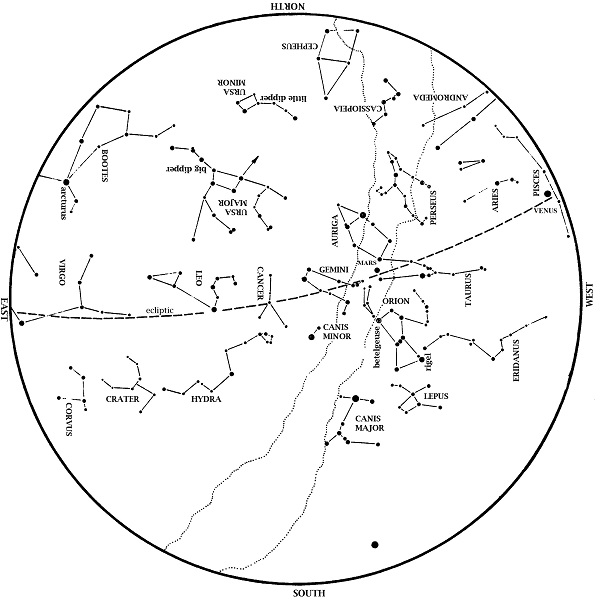Editor’s Note: We are looking up as HMNS Astronomer James Wooten explains the sky happenings for the month of March with a reminder that Daylight Savings Time is upon us.
Jupiter is still in the evening sky as March begins. However it appears a little lower in the west at dusk each evening as Venus pulls away from it this month. By the 31st, it is lost in the Sun’s glare. Jupiter is brighter than any star we ever see at night.
Venus is higher in the evening sky this month. It is slightly higher in the west at dusk each evening. Watch as Venus pulls away from Jupiter during March; those planets are only about a half-degree apart on March 1.
Mars was up all night long in December, and is now almost overhead at dusk. (It is high in the west by the 31st .) As Earth continues to pull away from Mars, Mars is a little dimmer each evening. In March 2023, though, Mars still outshines most of the stars at night.
Saturn slowly emerges into the morning sky by the end of the month.

Brilliant winter stars shift towards the southwest during March. Dazzling Orion is almost due south at dusk. His three-starred belt is halfway between reddish Betelgeuse and bluish Rigel. Orion’s belt points up to Aldebaran in Taurus the Bull. To Orion’s upper left are the twin stars Castor and Pollux, marking the heads of Gemini, the Twins. You can find Sirius, the brightest star we ever see at night, by drawing a line from Orion’s belt towards the horizon. To Orion’s left, about level with Betelgeuse, is Procyon, the Little Dog Star.
Under Sirius and low to the southern horizon this month is a star that most Americans never get to see—Canopus. Representing the bottom (keel) of the legendary ship Argo, Canopus is the second brightest star ever visible at night. Thus, it is clearly noticeable along the southern horizon on February and March evenings. However, you must be south of 37 degrees north to see Canopus rise. (This is the line that divides Utah, Colorado, and Kansas from Arizona, New Mexico, and Oklahoma.)
Joining the winter stars are stars of spring rising in the east. Look for Leo, the Lion at dusk. Later in the evening, extend the Big Dipper’s handle to ‘Arc to Arcturus’ and then ‘speed on to Spica’; these stars rise at about 10:00 in early March but by 9pm on the 31st.

Taurus, the Bull, is now high in the west. Dazzling Orion, the Hunter is high in the southwest, with his two dogs behind him. Sirius, the Big Dog Star, is the brightest star we ever see at night. Look for Canopus on the southern horizon below Sirius. In the north, the Big Dipper is higher in the sky. Leo, the Lion, and Virgo, the Virgin, rise in the east. These stars, along with Arcturus, announce the coming spring.
Moon Phases in March 2023
Full March 7, 6:40 a.m.
Last Quarter March 14, 9:08 p.m.
New March 21, 12:23 p.m.
1st Quarter March 28, 9:32 p.m.
Sunday, March 12, is the second Sunday of March. Accordingly, Daylight Saving Time begins at 2:00 am on this date. (The time jumps from 1:59 am to 3:00, skipping the 2:00 hour). Don’t forget to set your clocks forward one hour Saturday night, March 11!
At 4:25 pm on Monday, March 20, the Sun appears directly overhead at the equator, shifting northwards. Thus, this is our spring equinox, a day when everyone in the world gets the same amount of daylight. This is also when daytime, which has been lengthening since the winter solstice, becomes longer than night. Below the equator, of course, the reverse is true. There daytime has been shortening since late December and becomes shorter than night at the equinox. Autumn, rather than spring, is underway.
Our George Observatory is now open every Saturday night for observing! Purchase tickets in advance on our website.
Clear Skies!
Looking for last month’s Sky Happenings? Click here.






